Retired repairmen volunteer to fix home damages for residents in old districts
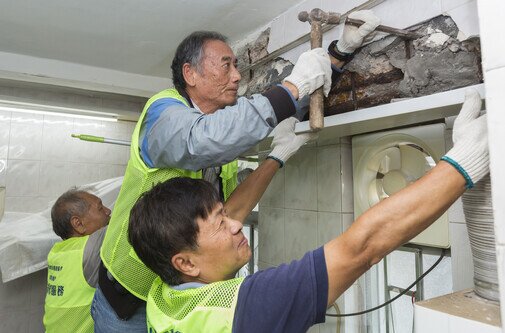
Carrying along their toolboxes, Yu Yuet Cham and Chiang Kam Choi set off for work in just another ordinary day as repair masters, despite that they have retired already. Having devoted over 40 years of their careers in home repairs, Yu and Chiang, now aged over 60, are passionate enough to volunteer to help needy residents in old districts with inspections and home repairs, at no cost.
It all started in June last year when the Urban Renewal Authority (URA) got together with local community groups to launch a half-year initiative, the “Home Repair Services Community Programme”, providing free repair services to grassroots families and elderly people living in Kowloon City. The aim of the scheme was not simply to improve their living environment, but also to spread the message about the importance of regular home maintenance. Up till mid-November 2018, the URA has received 132 cases requesting home repairs, of which 122 have been completed. Over half of the beneficiaries were elderly people living alone or elderly couples. About 10 percent were families living in old buildings in the URA’s redevelopment project site.
To better connect with the needy residents, a total of 60 people in the neighborhood were recruited as home repairs ambassadors and volunteer repairmen. After receiving training on home visits and communications skills, the volunteers not only regularly visited the residents to arrange repairs but also took the opportunity to spread the word about the new programme in the community. Yu and Chiang, two enthusiastic volunteers among them, accommodated nearly all kinds of requests from replacing door hinges to fixing electrical switches and leaking water pipes. They also managed every step of the repair works from initial inspection, sourcing materials to carrying out the works.
Working in pairs, the repairmen often took an average of two hours to finish inspection and repair work for one case. Given that more time were needed for some cases with additional items to be fixed upon inspection, the pair could serve two to five cases a day, covering repair items such as replacing water pipes, washbasins and toilet water tanks, as well as repairing electric wiring, lighting and interior concrete surfaces.
Being a volunteer repairman was not an easy job, especially when one had to lug his toolbox plus a luggage case containing a 20-pound electric hammer drill and climb up the winding staircases of old buildings. Though exhausted and soaked with sweat, Master Chiang said, “We don't think it’s arduous. We’re just happy to help people out. Besides, our legs can get a good workout.”
On this day, Masters Yu and Chiang were fixing a ceiling beam in the kitchen of Granny Lau’s flat, which is in the 54-year-old Comfort House at To Kwa Wan, a building that once undertook rehabilitation under the “Operation Building Bright” scheme in 2012. Granny Lau, aged 85 and living alone, recalled two big pieces of concrete fell from the beam a month ago, yet luckily she wasn’t there at that time. Since the concrete kept spalling, she was referred by the building’s management office and a district councillor to participate in the programme. “I am not even able to replace the fluorescent light tubes at my home when they’re out of order. If there wasn’t the help from the masters, I would not know what to do,” said Granny Lau thankfully.
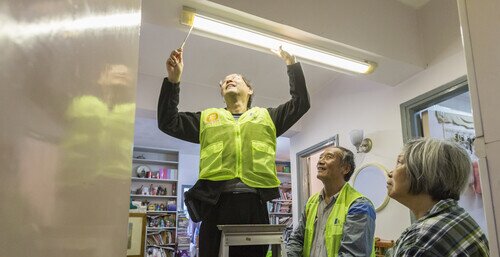 Volunteer repairmen help a single elderly Ms Chow to mend her lighting.
Volunteer repairmen help a single elderly Ms Chow to mend her lighting.
As shown by the rusty reinforcement bars exposed from the concrete beam, Master Chiang told that there had been decades-long water seepage in the flat that caused dampness and swelling of the reinforcement bars, eventually leading to cracks in the ceiling and the spalling of concrete. “The most urgent task at the moment is the removal of those loose concrete to prevent it from falling and hurting Granny. After that, we will patch the hacked area and paint the ceiling. It would take at least 3 days to complete the job,” said Chiang. While repairmen in the market would ask for $5000 to $6000 on a similar job, which would be quite a financial burden for elderly flat owners, Chiang hoped their volunteer work could help save up some costs for the elderly. “We do our best to help in every case, yet sometimes the damages might be too severe and difficult to repair.”
In urban districts, while maintenance of common areas of many old buildings have already been covered by “Operation Building Bright” and “Integrated Building Rehabilitation Assistance Scheme”, other parts of the buildings are often left unattended as the responsibility to maintain the interior of flat units, which usually comprises three quarters of the building’s gross floor area, is rested solely on the owners. As such, it is crucial to promote the importance of regular home repairs and maintenance to private owners amid their low awareness. For many elderly flat owners, home repair is the pain in the neck.
Master Yu said few repairmen are willing to work for the elderly in old districts because of the relatively low fees, coupled with having to climb up the stairs of tenement buildings, while other repairmen may ask for prices so high which frighten off owners from doing repairs. “I’ve lived in To Kwa Wan for 45 years and have real affection for this neighbourhood. It’s a real shame to see there’s no help for the elderly who may just want to change their broken light bulbs. It’s most gratifying that I can use my expertise to help the elderly repair their homes,” said Yu.
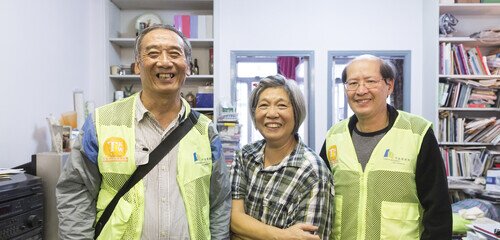 Master Yu (1st from right) says it’s most gratifying that he can use his expertise to help the elderly repair their homes, while Master Chiang (1st from left) says his relation with neighbours has been enhanced through volunteer work.
Master Yu (1st from right) says it’s most gratifying that he can use his expertise to help the elderly repair their homes, while Master Chiang (1st from left) says his relation with neighbours has been enhanced through volunteer work.
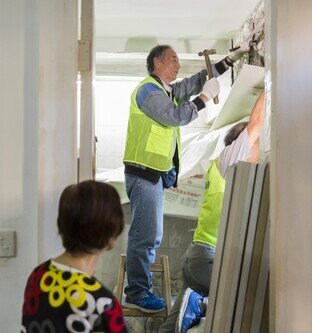 Master Chiang helps fix the ceiling to prevent concrete from spalling.
Master Chiang helps fix the ceiling to prevent concrete from spalling.
Living in a tenement building at Whampoa, Ms Chow, a single elderly, had her lighting and toilet water tank fixed with the help from Yu and Chiang. “My left hand was injured so I couldn’t mend the broken light and water tank in my toilet. Fortunately the repairmen came very soon to help and they even inspected the electric panel to make sure my flat was safe,” said Ms Chow. “Since this programme was initiated by the URA and their repairmen were licensed, my mind was put entirely at ease.”
Of all the cases, Chiang was most impressed by the living conditions of dwellers in the subdivided flats. One family of three in a rented room had no separate system for salt water flushing supply, so they could only use fresh water for toilet flushing. It costed them more than $900 or sometimes even over $1000 each month to pay for the water bills as their water tank was also leaking.
“After replacing the stop cock, water tap and parts in the water tank, the family finally had salt water for toilet flushing. This greatly reduced the water bill, and the money saved can be used to buy exercise books for the child,” said Chiang. He also expressed that the repair services not only have helped the needy with home repairs, but also enhanced relations between volunteers and residents.
With good responses from the residents, the URA has decided to launch the second round of the programme to cater for the pressing demand for home repairs in the district. Apart from Kowloon City, the URA also partnered with local community groups last August to launch a 9-month pro bono programme offering free home repair services for Sham Shui Po residents in the hope of helping about 120 families, especially for those living in poor conditions, on home repairs as well as to raise their awareness of the importance of building maintenance. The URA looks forward to extending their services to more districts in future and benefitting more residents, which will ultimately help enhance the environment of both inside and outside of their homes.
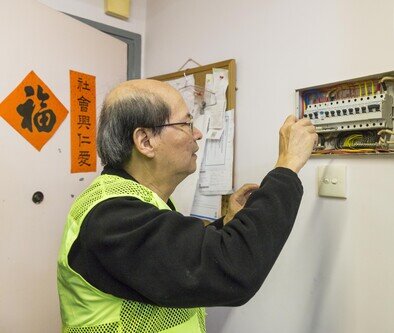 Master Yu helps fix the fuse box.
Master Yu helps fix the fuse box.
